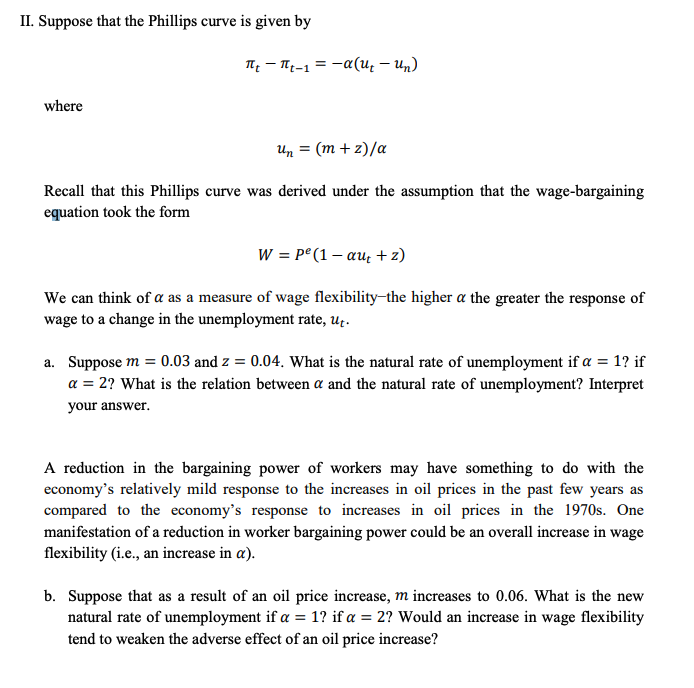II. Suppose that the Phillips curve is given by TH - T-1 = -a(u, – Un) where Un = (m + z)/a Recall that this Phillips curve was derived under the assumption that the wage-bargaining equation took the form W = p° (1 – au + z) We can think of a as a measure of wage flexibility-the higher a the greater the response of wage to a change in the unemployment rate, uț. a. Suppose m = 0.03 and z = 0.04. What is the natural rate of unemployment if a = 1? if a = 2? What is the relation between a and the natural rate of unemployment? Interpret your answer.
II. Suppose that the Phillips curve is given by TH - T-1 = -a(u, – Un) where Un = (m + z)/a Recall that this Phillips curve was derived under the assumption that the wage-bargaining equation took the form W = p° (1 – au + z) We can think of a as a measure of wage flexibility-the higher a the greater the response of wage to a change in the unemployment rate, uț. a. Suppose m = 0.03 and z = 0.04. What is the natural rate of unemployment if a = 1? if a = 2? What is the relation between a and the natural rate of unemployment? Interpret your answer.
Principles of Economics 2e
2nd Edition
ISBN:9781947172364
Author:Steven A. Greenlaw; David Shapiro
Publisher:Steven A. Greenlaw; David Shapiro
Chapter21: Unemployment
Section: Chapter Questions
Problem 43CTQ: Is it desirable to eliminate natural unemployment? Why or why not? Hint: Think about what our...
Related questions
Question
a and b

Transcribed Image Text:II. Suppose that the Phillips curve is given by
TH - T-1 = -a(u, – Un)
where
Un = (m + z)/a
Recall that this Phillips curve was derived under the assumption that the wage-bargaining
equation took the form
W = p° (1 – au + z)
We can think of a as a measure of wage flexibility-the higher a the greater the response of
wage to a change in the unemployment rate, uț.
a. Suppose m = 0.03 and z = 0.04. What is the natural rate of unemployment if a = 1? if
a = 2? What is the relation between a and the natural rate of unemployment? Interpret
your answer.
A reduction in the bargaining power of workers may have something to do with the
economy's relatively mild response to the increases in oil prices in the past few years as
compared to the economy's response to increases in oil prices in the 1970s. One
manifestation of a reduction in worker bargaining power could be an overall increase in wage
flexibility (i.e., an increase in a).
b. Suppose that as a result of an oil price increase, m increases to 0.06. What is the new
natural rate of unemployment if a = 1? if a = 2? Would an increase in wage flexibility
tend to weaken the adverse effect of an oil price increase?
Expert Solution
This question has been solved!
Explore an expertly crafted, step-by-step solution for a thorough understanding of key concepts.
This is a popular solution!
Trending now
This is a popular solution!
Step by step
Solved in 2 steps with 2 images

Knowledge Booster
Learn more about
Need a deep-dive on the concept behind this application? Look no further. Learn more about this topic, economics and related others by exploring similar questions and additional content below.Recommended textbooks for you

Principles of Economics 2e
Economics
ISBN:
9781947172364
Author:
Steven A. Greenlaw; David Shapiro
Publisher:
OpenStax

Principles of Economics 2e
Economics
ISBN:
9781947172364
Author:
Steven A. Greenlaw; David Shapiro
Publisher:
OpenStax